PDF to Excel Converter Bank Statement
PDF to Excel converter bank statement helps convert financial data into editable spreadsheets with precision. Easily manage transactions and simplify accounting tasks.
Add Your File
Drag & Drop Or Select File
Data security is our top priority
Bank Statement Converters prioritises the confidentiality and integrity of your data. As a testament to our commitment, we adhere to stringent compliance standards, including GDPR, SOC 2, and HIPAA. Privacy Policy



How to Convert Your Bank Statement with PDF to Excel Converter
Why Choose PDF to Excel Converter Bank Statement?
Accessibility
Bank Statement Converter easily converts credit card statements or bank account data into Excel format or CSV files without technical skills.
Affordable Plans for Everyone
Affordable Plans for Everyone tailored to meet diverse needs without breaking the bank, offering flexibility and value for all.
Starter
$90 / month
Save 10% annually
Why should you take this
4,800 pages per year
PDF Bank Statement to Excel
PDF Bank Statement to CSV
Convert Password Protected Statement
Multiple PDFs to a Single CSV
Global Banks Supported
Get Started
Professional
$180 / month
Save 20% annually
Why should you take this
12,000 pages per year
PDF Bank Statement to Excel
PDF Bank Statement to CSV
Convert Password Protected Statement
Multiple PDFs to a Single CSV
Global Banks Supported
Get Started
Business
$360 / month
Save 20% annually
Why should you take this
48,000 pages per year
PDF Bank Statement to Excel
PDF Bank Statement to CSV
Convert Password Protected Statement
Multiple PDFs to a Single CSV
Global Banks Supported
Get Started
Most Popular
Enterprise
$Custom / month
Save 20% annually
Why should you take this
PDF Bank Statement to Excel
PDF Bank Statement to CSV
Convert Password-Protected Statement
Multiple PDFs to a Single CSV
Global Banks Supported
Get Started
PDF to Excel Converter vs. Built-In PDF Readers: What’s More Effective?
Features
PDF to Excel Converter
Built-In PDF Reader
Converts PDF tables to Excel format
Preserves columns and row structure
Exports to editable Excel (.XLSX)
Detects and separates data fields
Supports bulk/batch file conversion
Recognizes numeric and date formats
Built for data extraction
Allows table preview before export
Ready for accounting and reports
Time saving for financial tasks
Frequently Asked Questions
Can I edit the extracted data after conversion?
Will the converter keep the same format as my bank statement?
Can I use a bank statement converter for credit card statements?
Dealing with bank statements in PDF format can be a hassle, especially when you need to edit or analyze financial data. If you’ve ever found yourself manually copying numbers or fixing formatting issues, you know how frustrating it can be.
That’s where a PDF to Excel converter bank statement tool comes in—it quickly turns your PDFs into clean, editable Excel sheets.
Without a converter, entering transactions manually is not only time-consuming but also increases the risk of errors. Scanned PDFs make things even trickier. A reliable tool saves you time and ensures accuracy.
In this article, you’ll see why a PDF to Excel converter is essential, the common challenges you might face, and how to pick the best tool for your needs.
What Is a PDF to Excel Converter?
A PDF to Excel converter is a tool that converts bank statements from PDF format into editable Microsoft Excel spreadsheets. It helps extract transaction details, organize financial data, and reduce manual data entry errors, making it easier to analyze and manage banking records efficiently.
When you receive bank statements in PDF format, they are often non-editable, making it difficult to copy, sort, or analyze your financial data.
A PDF to Excel converter solves this problem by extracting the transaction details and converting them into an Excel file. This allows you to work with the data freely—whether it’s for budgeting, accounting, or financial analysis.
Manually entering data from PDFs into Excel is time-consuming. Some bank statements are scanned images, making the process even harder. A good tool to convert statement to Excel ensures accuracy, saves time, and makes financial management easier by providing well-structured, editable spreadsheets.
What Makes PDF to Excel Bank Statement Conversion Useful?
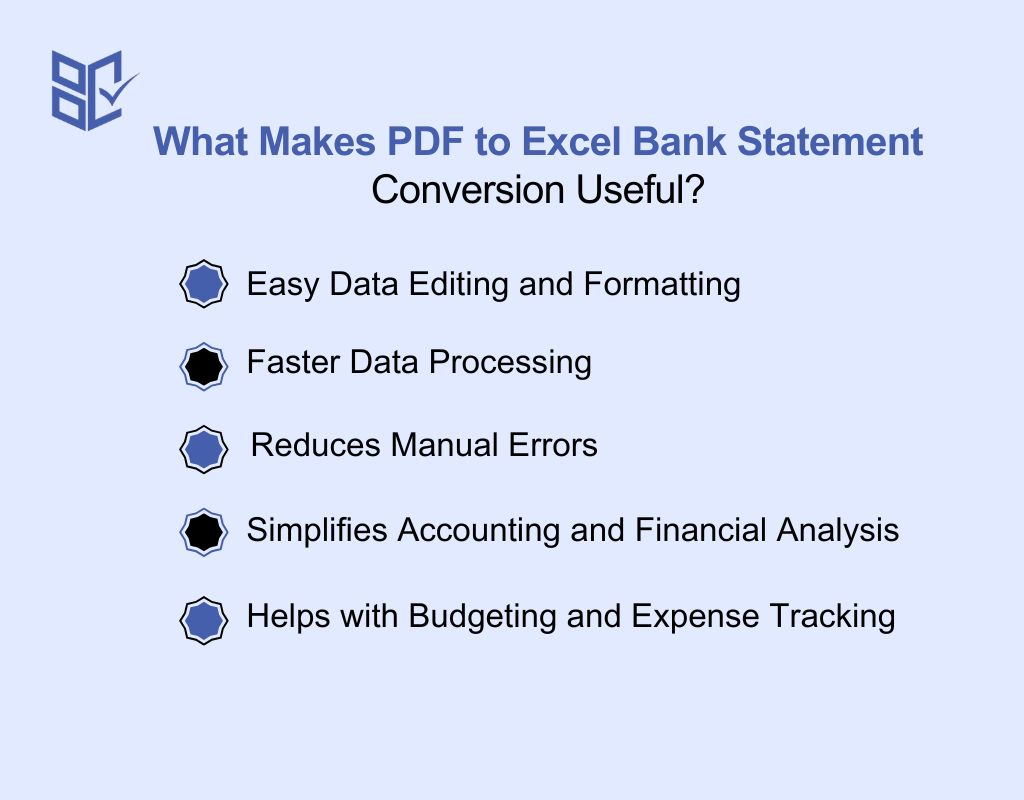
Bank statements in PDF format can be difficult to work with, especially when you need to edit, sort, or analyze transactions. Converting them to Excel makes financial management easier. Here are some key reasons why using a PDF to Excel converter bank statement is beneficial:
Easy Data Editing and Formatting
PDFs are non-editable, making it hard to modify transaction details. Converting them to Excel allows you to edit, format, and rearrange data effortlessly. You can categorize expenses, add formulas, and customize the sheet to fit your financial needs.
Faster Data Processing
Manually entering data from PDFs into Excel is slow and tiring. A PDF to Excel converter automates this process, saving you time. This is especially useful for businesses and individuals handling multiple bank statements regularly.
Reduces Manual Errors
Typing numbers manually increases the risk of errors, which can lead to financial miscalculations. A converter ensures accurate data extraction, minimizing mistakes and helping you maintain error-free financial records.
Simplifies Accounting and Financial Analysis
Excel offers powerful tools for financial analysis, such as formulas, graphs, and pivot tables. Converting your bank statements to Excel makes it easier to track spending, generate reports, and make informed financial decisions.
Helps with Budgeting and Expense Tracking
Converting your bank statements to Excel lets you organize transactions and track expenses efficiently. You can categorize payments, set financial goals, and monitor spending habits to improve money management.
Step-by-Step Guide to Convert PDF Bank Statement to Excel
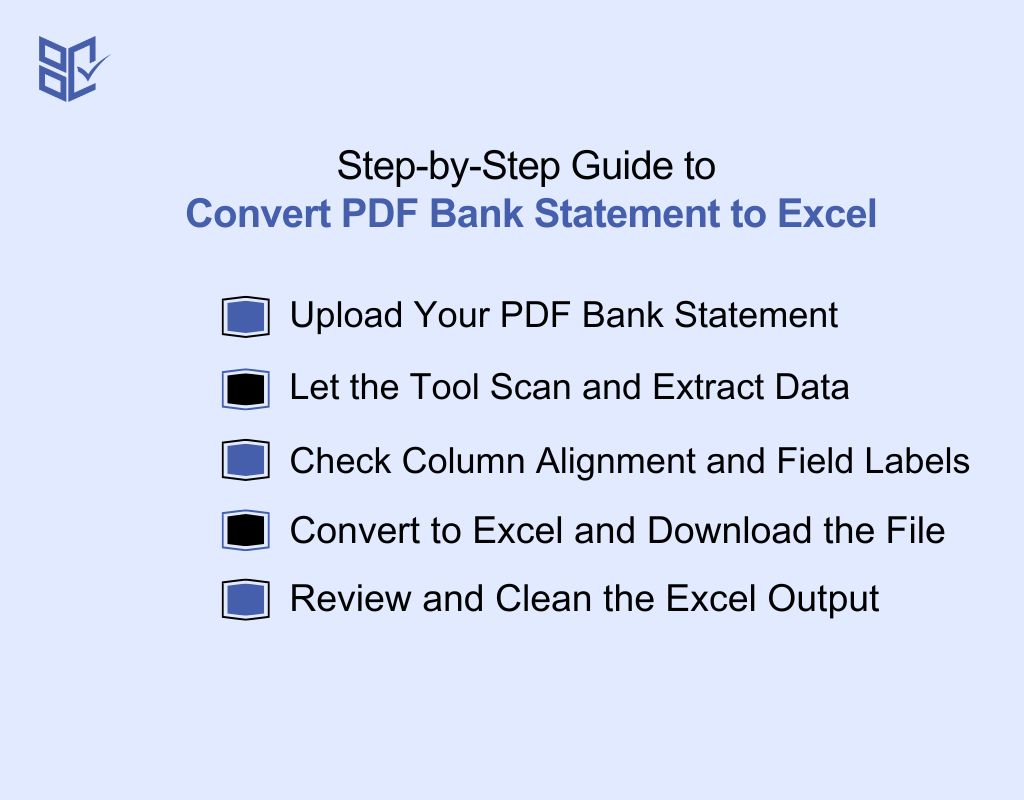
If your bank statement is in PDF, converting it to Excel can save time and help you manage your data better. Here’s a simple guide on how to convert bank statement to Excel:
Upload Your PDF Bank Statement
First, pick a tool that supports bank statement conversion. Upload your PDF file directly to the tool. Make sure your file is not blurry or password-protected to avoid errors during processing. Clean files lead to better results.
Let the Tool Scan and Extract Data
The converter will scan your file and extract all the data—dates, amounts, and descriptions. It detects table structures and lines automatically. You don’t need to adjust anything manually at this stage.
Check Column Alignment and Field Labels
Once data appears, check if columns like "Date," "Amount," and "Description" are in the right place. Some converters let you adjust headers if anything is missing or misaligned.
Convert to Excel and Download the File
Now click the convert or export button. Your data is transformed into an Excel file (.xlsx). You can download it instantly and open it in Excel or Google Sheets for use.
Review and Clean the Excel Output
Open the file and review all rows. Check for split rows, missing values, or extra spaces. Clean the sheet if needed. Your Excel file is now ready for sorting and analysis.
Who Finds PDF to Excel Bank Statement Tools Essential?
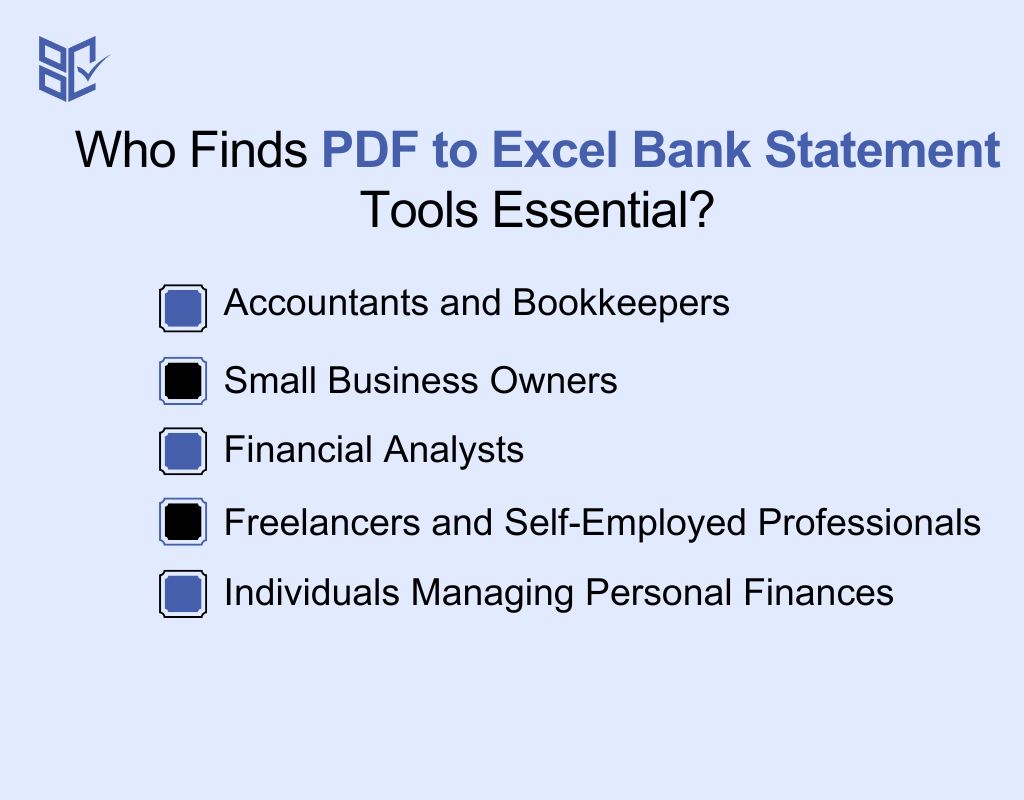
A PDF to Excel bank statement converter is useful for anyone who needs to organize, analyze, or manage financial data efficiently. Whether you're an individual or a professional, here are the key people who benefit from it:
Accountants and Bookkeepers
Accountants handle multiple bank statements daily for financial reporting and tax preparation. Converting PDFs to Excel helps them organize transactions, detect errors, and reconcile bank accounts faster, making bookkeeping more accurate and efficient.
Small Business Owners
Managing business finances requires tracking expenses, invoices, and payments. A PDF to Excel bank statement converter helps business owners analyze cash flow, monitor spending, and prepare financial reports without manual data entry.
Financial Analysts
Financial analysts work with large datasets to assess business performance and trends. Converting bank statements to Excel allows them to sort transactions, use formulas, and create reports for better decision-making and strategy planning.
Freelancers and Self-Employed Professionals
Freelancers need to keep track of income and expenses for tax filings and budgeting. Using a PDF to Excel bank statement tool helps them manage finances more easily and prepare accurate reports for clients or accountants.
Individuals Managing Personal Finances
Anyone tracking personal expenses, savings, or budgeting can benefit from converting PDFs to Excel. It simplifies organizing transactions, categorizing spending, and gaining financial insights to improve money management and financial planning.
PDF to Excel Bank Statement Errors and How to Fix Them
When converting a PDF to Excel bank statement, you might face some common issues that affect the accuracy of your financial data. Below is a table with the most common problems, their causes, and solutions:
Issues | Causes | Solutions |
Misaligned Data | The conversion tool misinterprets table structures, leading to misplaced data. | Use an advanced converter with better table recognition or manually adjust columns after conversion. |
Extra Blank Rows and Columns | Some converters add unnecessary spaces or blank rows between transactions. | Remove extra rows and columns in Excel using ‘Find & Select’ > ‘Go To Special’ > ‘Blanks’. |
Numbers Stored as Text | Amounts and balances are converted as text, preventing calculations. | Use Excel’s ‘Text to Columns’ or ‘VALUE’ function to convert text into numbers. |
Scanned PDF Not Converting Properly | Scanned bank statements require OCR, which may misread or miss some text. | Use an OCR-based PDF to Excel converter to improve text recognition. |
Merged Cells Affecting Data Structure | Cells merge during conversion, making it hard to sort and filter data. | Unmerge cells in Excel by selecting ‘Merge & Center’ and clicking ‘Unmerge Cells’. |
Incorrect Date Formatting | Dates are interpreted incorrectly or displayed in an unusable format. | Use Excel’s ‘DATEVALUE’ or ‘Text to Columns’ function to correct date formatting. |
Loss of Special Characters or Symbols | Currency symbols, percentage signs, or special characters are lost during conversion. | Manually reinsert missing symbols or adjust the formatting in Excel. |
Large File Size Causing Errors | Large PDFs with too many transactions can cause conversion failures. | Compress the PDF before conversion or split it into smaller files. |
Duplicate Transactions Appearing | The tool mistakenly duplicates some transactions, causing confusion in reports. | Use Excel’s ‘Remove Duplicates’ feature under the ‘Data’ tab. |
Missing or Incomplete Data | Some transactions may not be extracted properly, leading to incomplete statements. | Verify the original PDF and try using a different converter or extraction method. |
Smart Ways to Choose a PDF to Excel Bank Statement Conversion Tool
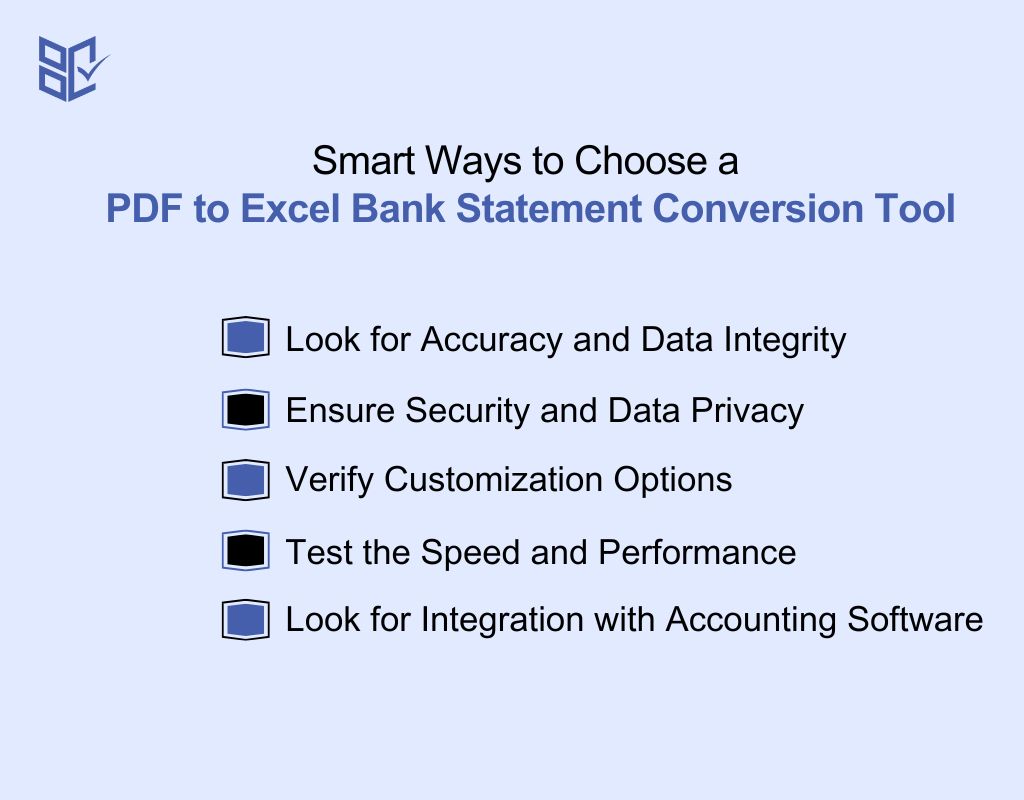
Managing financial data can be tricky, especially when you need to convert bank statements into different formats. A good bank statement converter saves you time and ensures accuracy. Here’s how to pick the best one:
Look for Accuracy and Data Integrity
A good PDF to Excel converter should extract and transfer data correctly without altering important details. Any errors in conversion can lead to incorrect financial records, which can cause serious issues. Test the tool with sample statements to verify its accuracy before relying on it for important tasks.
Ensure Security and Data Privacy
Your bank statements contain sensitive financial information, so security is important. Choose a converter that uses encryption and does not store or share your data. If it’s an online tool, check for SSL certification and user reviews to ensure your information is safe.
Verify Customization Options
Some PDF to Excel bank statement converters allow you to adjust settings like currency formats, column arrangements, and date formats. This can be useful if you have specific accounting requirements. The ability to customize outputs ensures the converted files match your financial management needs.
Test the Speed and Performance
A slow converter can be frustrating, especially if you handle large amounts of financial data. Try converting a sample statement to check how fast the tool processes information. A good converter should be quick without compromising accuracy or security.
Look for Integration with Accounting Software
If you use accounting software like QuickBooks, Xero, or Tally, choose a converter that integrates easily. This feature saves time and effort by directly transferring financial data without manual uploads. Compatibility with accounting tools ensures a seamless workflow.
Understanding the PDF to Excel Bank Statement Conversion
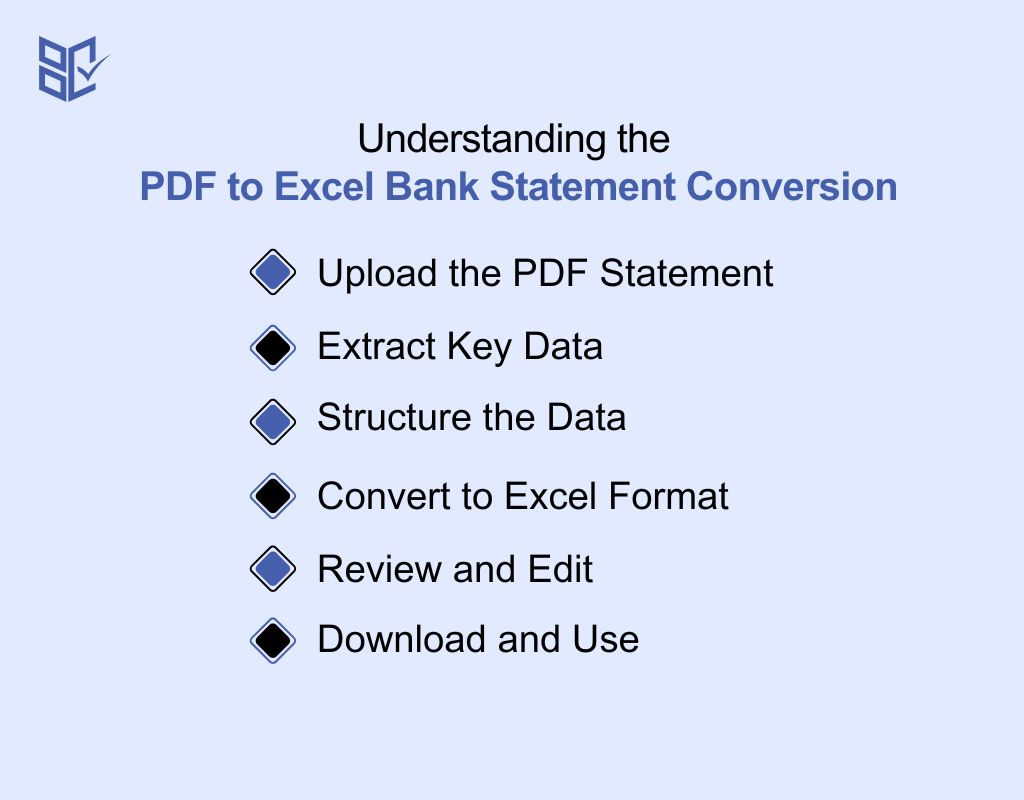
A bank statement PDF to Excel converter helps you turn unstructured PDF data into a clean, editable Excel format. Here's how the process works, step by step:
Upload the PDF Statement
You begin by uploading your bank statement. Most tools support PDFs from banks or scanned documents. Some let you drag and drop the file, while others need you to select it from your device.
Extract Key Data
The converter scans the PDF to extract important data like transaction dates, descriptions, amounts, and balances. Tools with OCR technology can read scanned or image-based PDFs too. This avoids manual typing and ensures accuracy.
Structure the Data
Once extracted, the data is organized into columns. Deposits, withdrawals, and balances are sorted properly. Some tools let you rename columns or change formats to fit your accounting setup.
Convert to Excel Format
After structuring the data, the tool converts it to Excel (XLS or XLSX). This format makes it easy to filter, sort, or calculate within Excel or upload it to accounting tools like QuickBooks.
Review and Edit
Before downloading, many tools let you review the data. You can edit descriptions, fix categories, or delete duplicates. This step helps prevent errors in your financial records.
Download and Use
Finally, you download the Excel file. It’s now ready for use in bookkeeping, expense tracking, or tax filing. Some tools also support direct export to accounting software.
Trusted PDF to Excel Converters for Bank Statements
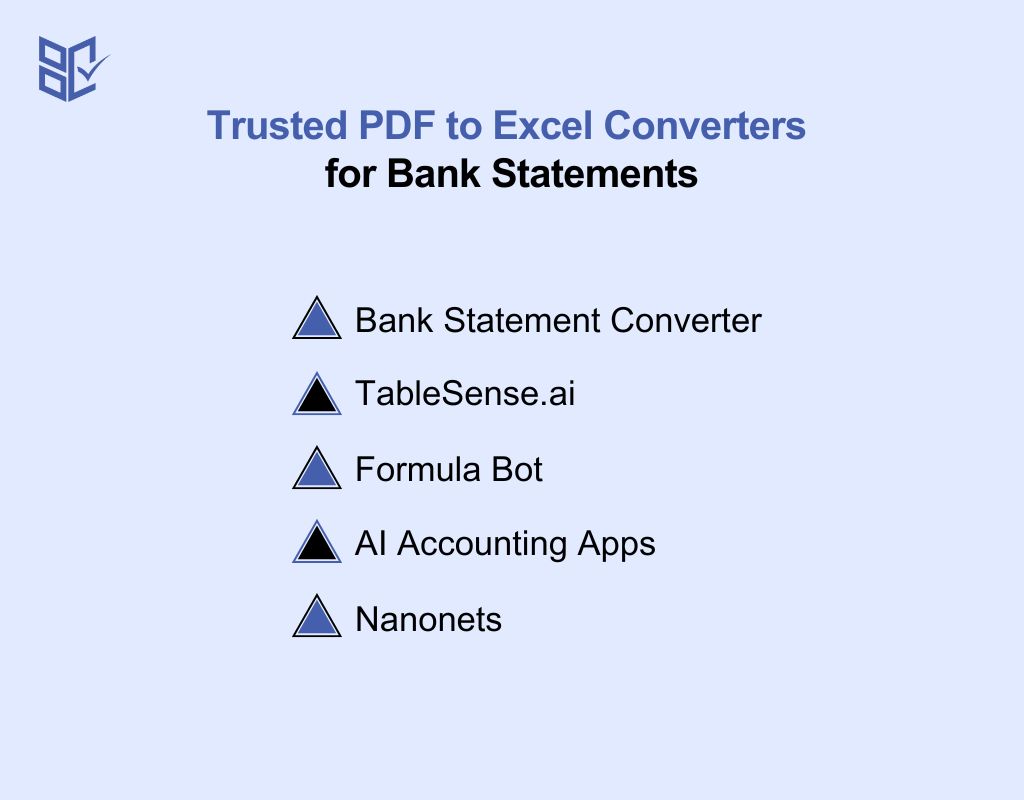
Converting PDF bank statements to Excel can save time and effort, especially for financial management and accounting. The right tool should be accurate, secure, and user-friendly. Here are the top PDF to Excel bank statement converters you can consider:
Bank Statement Converter
Bank Statement Converter turns PDF bank statements into Excel format with high accuracy. It supports statements from thousands of banks worldwide, ensuring seamless data extraction. The interface is simple, and the tool is designed for professionals and individuals who need quick, error-free conversions.
TableSense.ai
TableSense.ai uses artificial intelligence to process and extract financial data from PDFs. It converts cluttered bank statements into well-structured XLSX, CSV, or JSON formats. The tool is ideal for businesses and accountants who require detailed and precise financial reporting with minimal manual effort.
Formula Bot
Formula Bot automates the conversion process, turning PDF bank statements into Excel spreadsheets quickly and efficiently. It ensures data accuracy, reducing errors in financial records. This AI-powered tool is useful for professionals who handle multiple statements and need fast, reliable results.
AI Accounting Apps
This tool supports converting PDFs, photos, and screenshots of bank statements into various formats like Excel, CSV, and OFX. It works with over 1,000 banks globally, making it highly versatile. AI-driven technology ensures precision in data extraction, saving users significant time.
Nanonets
Nanonets offers a free, AI-powered bank statement converter that can process up to 500 pages without requiring a signup. It converts PDFs into structured Excel or CSV files, making it perfect for users who need quick, hassle-free financial data extraction with minimal effort.
Conclusion
Managing financial data doesn’t have to be frustrating! With the right PDF to Excel converter bank statement, you can turn messy statements into organized spreadsheets in just a few clicks. No more manual data entry, no more errors—just quick, accurate, and secure financial management.
Before making a choice, explore the options, check for essential features, and test a free trial if available. A good tool will save you time, reduce stress, and make your workflow seamless. Now, go ahead—choose the best converter and simplify your life!